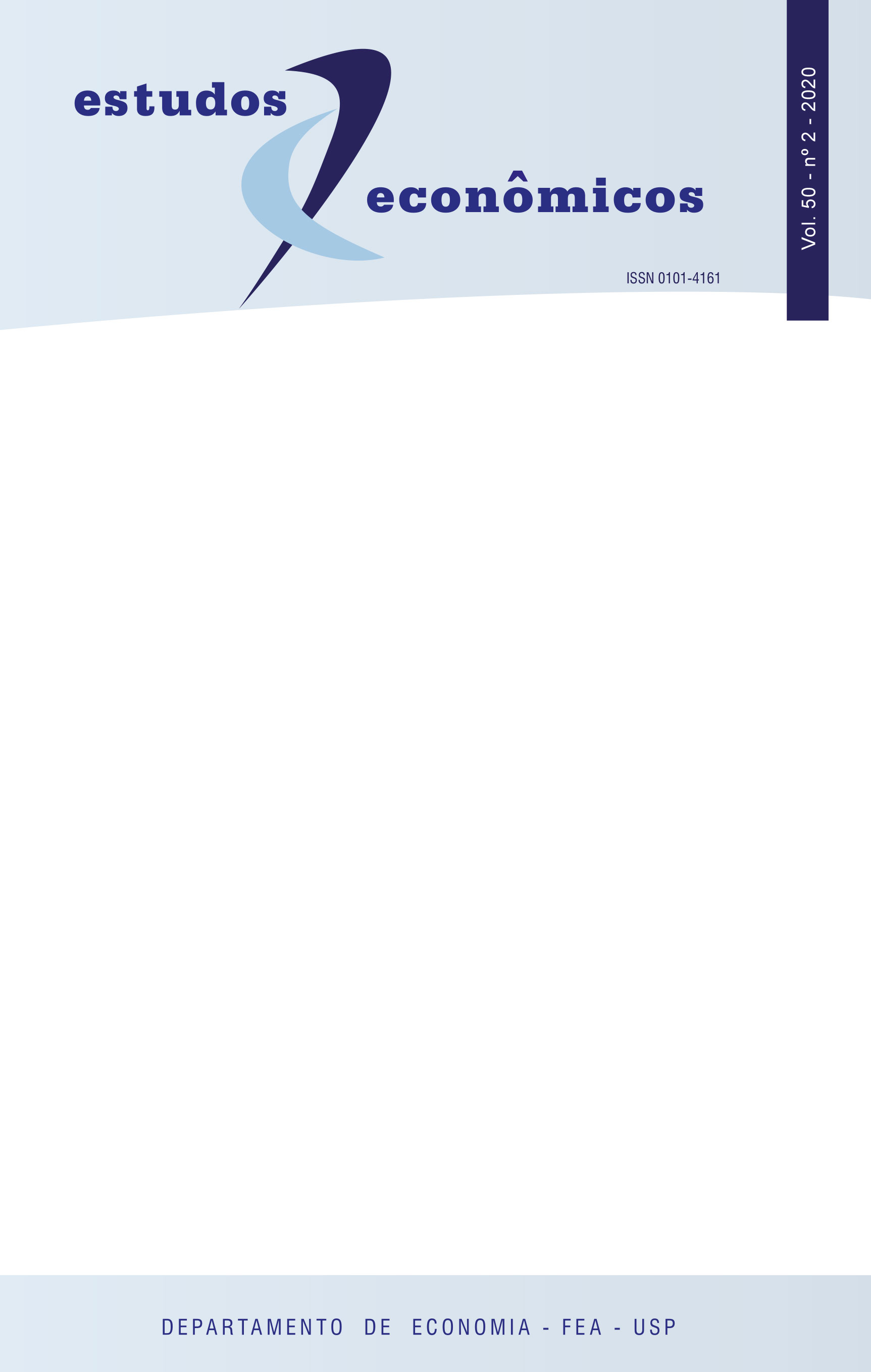Agregação de dinâmicas heterogêneas, acurácia da meia-vida e o enigma da PPC: evidência para cidades brasileiras
DOI:
https://doi.org/10.1590/http://dx.doi.org/10.1590/0101-41615025fbrPalavras-chave:
Viés de heterogeneidade, Meia-vida, Enigma da PPCResumo
O enigma da PPC é apontado como um dos seis mais importantes puzzles da macroeconomia internacional. IMRR (2005a) apontam o viés de agregação de preços com dinâmica de ajuste heterogêneo como solução para o enigma. Este trabalho averigua se este resultado é suportado para dados de cidades brasileiras utilizando-se o estimador CCEMG dinâmico, proposto por Chudik e Pesaran (2015), com correção half-panel jackknife para o viés do estimador OLS em amostra pequena. Os resultados corroboram a evidência de IMRR (2005a), com uma meia-vida mediana de 13,5 meses.
Downloads
Referências
Arellano, M.; Bover, O. 1995. “Another Look at the Instrumental-variable Estimation of Error-components Model.” Journal of Econometrics 68: 29-52.
Arruda, E.; Barbosa, R. B. Guimarães, D. B.; Castelar, I. 2015. “Price Convergence, Reversal Speed and Purchasing Power Parity: Stylized Facts for Brazilian Cities.” In: XVII Encontro de Economia da Região Sul – XVII ANPEC SUL, Maringá.
Bastos, F. S.; Ferreira, R. T.; Arruda, E. F. 2018. “Speed of Reversion of Deviations of the Purchasing Power Parity for Brazilian Cities.” Revista Brasileira de Economia 72, no.1: 26-40.
Blundell, R.; Bond, S. 1998. “Initial Conditions and Moment Restrictions in Dynamic Panel Data Models.” Journal of Econometrics 87: 115-143.
Carvalho, C.; Nechio, F. 2011. “Aggregation and the PPP Puzzle in a Sticky-Price Model.” The American Economic Review 101, no. 6: 2391-2424.
Chen, S-S.; Engel, C. 2005. “Does ‘Aggregation Bias’ Explain the PPP Puzzle?” Pacific Economic Review 10, no.1: 49-72.
Chmelarova, V.; Nath, H. K. 2010. “Relative Price Convergence Among US Cities: Does the Choice of Numeraire City Matter?” Journal of Macroeconomics 32: 405-414.
Chudik, A.; Pesaran, M. H. 2015. “Common Correlated Effects Estimation of Heterogeneous Dynamic Panel Data Models with Weakly Exogenous Regressors.” Journal of Econometrics 188, no.2: 393-420.
Dornbusch, R. 1976. “Expectations and Exchange Rate Dynamics.” Journal of Political Economy 84, no.6: 1161-1176.
Everaert, G.; Pozzi, L. 2007. “Bootstrap-based Bias Correction for Dynamic Panels.” Journal of Economic Dynamics and Control 31, no.4: 1160-1184.
Gadea, M. D.; Mayoral, L. 2009. “Aggregation is not Solution: The PPP Puzzle Strikes Back.” Journal of Applied Econometrics 24, no. 6: 875-894.
Han, C.; Phillips, P. C. B.; Sul, D. 2017. “Lag Length Selection in Panel Autoregression.” Econometric Reviews 36, no.1-3: 225-240.
Im, K. S.; Pesaran, M. H.; Shin, Y. 2003. “Testing for Unit Roots in Heterogeneous Panels.” Journal of Econometrics 115, no.1: 53-74.
Imbs, J.; Mumtaz, H.; Ravn, M. O.; Rey, H. 2005a. “PPP Strikes Back: Aggregation and the Real Exchange Rate.” The Quarterly Journal of Economics 120, no.1: 1-43.
Imbs, J.; Mumtaz, H.; Ravn, M. O.; Rey, H. 2005b. ““Aggregation Bias” Does Explain the PPP Puzzle.” National Bureau of Economic Research Working Paper 11607. Disponível em < http://www.jeanimbs.com/papers2_files/PPPreply.pdf >. Acesso em 07/11/2017.
Kilian, L. 1998. “Small-Sample Confidence Intervals for Impulse Response Functions.” The Review of Economics and Statistics 80, no.2: 218-230.
Kilian, L.; Zha, T. 2002. “Quantifying the Uncertainty about the Half-Life of Deviations from PPP.” Journal of Applied Econometrics 17, no.2: 107-125.
Levin, A.; Lin, C.-F.; Chu, C.-S. J. 2002. “Unit Root Tests in Panel Data: Asymptotic and Finite-sample Properties.” Journal of Econometrics 108, no.1: 1-24.
Mayoral, L. 2013. “Heterogeneous Dynamics, Aggregation, and the Persistence of Economic Shocks.” International Economic Review 54, no.4: 1295-1307.
Mayoral, L.; Gadea, M. D. 2011. “Aggregate Real Exchange Rate Persistence through the Lens of Sectoral Data.” Journal of Monetary Economics 58, no.3: 290-304.
Nath, H. K.; Sarkar, J. 2014. “City Relative Price Dynamics in Australia: Are Structural Breaks Important?” Economic Record 90, no.288: 33-48.
Papell, D. H.; Theodoridis, H. 2001. “The Choice of Numeraire Currency in Panel Tests of Purchasing Power Parity.” Journal of Money, Credit and Banking 33: 790-803.
Pesaran, M. H. 2006. “Estimation and Inference in Large Heterogeneous Panels with Multifactor Error Structure.” Econometrica 74, no.4: 967-1012.
Pesaran, M. H. 2007. “A Simple Panel Unit Root Test in the Presence of Cross-section Dependence.” Journal of Applied Econometrics 22: 265-312.
Pesaran, M. H. 2015. “Testing Weak Cross-Sectional Dependence in Large Panels.” Econometric Reviews 34, no.6-10: 1089-1117.
Pesaran, M. H.; Yamagata, T. 2008. “Testing Slope Homogeneity in Large Panels.” Journal of Econometrics 142: 50-93.
Rogoff, K. 1996. “The Purchasing Power Parity Puzzle.” Journal of Economic Literature 34: 647-668.
Seong, B.; Morshed, A. K. M. M.; Ahn, S. K. 2006. “Additional Sources of Bias in Half-Life Estimation.” Computational Statistics & Data Analysis 51: 2056-2064.
Simões, O. R.; Marçal, E. F. 2012. “Agregação Temporal e Não-Linearidade Afetam os Testes da Paridade do Poder de Compra: Evidência a Partir de Dados Brasileiros.” Revista Brasileira de Economia 66, no.3: 375-399.
So, B. S.; Shin, D.W. 1999. “Recursive Mean Adjustment in Time Series Inferences.” Statistics and Probability Letters 43: 65-73.
Downloads
Publicado
Edição
Seção
Licença
Copyright (c) 2020 Felipe Sousa Bastos, Roberto Tatiwa Ferreira

Este trabalho está licenciado sob uma licença Creative Commons Attribution-NonCommercial 4.0 International License.
A submissão de artigo autoriza sua publicação e implica o compromisso de que o mesmo material não esteja sendo submetido a outro periódico.
A revista não paga direitos autorais aos autores dos artigos publicados.
O detentor dos direitos autorais da revista é o Departamento de Economia da Faculdade de Economia, Administração, Contabilidade e Atuária da Universidade de São Paulo.




